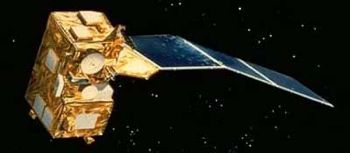Marine Observation Satellite (original) (raw)

Home - Search - Browse - Alphabetic Index: 0- 1- 2- 3- 4- 5- 6- 7- 8- 9
A- B- C- D- E- F- G- H- I- J- K- L- M- N- O- P- Q- R- S- T- U- V- W- X- Y- Z
Marine Observation Satellite

MOS-1b
Credit: Manufacturer Image
Japanese earth sea satellite. The MOS 1A and 1B satellites, also known as Momo 1A and 1B, were Japan's first Earth resources satellites.
AKA: Momo;MOS. Status: Operational 1987. First Launch: 1987-02-19. Last Launch: 1990-02-07. Number: 2 . Gross mass: 742 kg (1,635 lb). Height: 2.40 m (7.80 ft). Span: 11.50 m (37.70 ft).
The satellites were designed to monitor ocean currents, sea surface temperature, atmospheric water vapor, ocean chlorophyll levels, precipitation, and land vegetation. They also acted as relays for data from remote surface sensor platforms.
MOS 1B was upgraded for flight from the engineering model for MOS 1A. The spacecraft was nadir pointing, 3-axis stabilized with momentum wheels and hydrazine thrusters. Communications consisted of S-, X-band downlink, and S-band uplink. A single solar panel with 1-axis articulation provided power. The payload included:
- Multispectral Electronic Self-Scanning Radiometer (MESSR) - covers 4 bands between 0.51 and 1.1 micron, 50 m resolution, 200 km swath. Designed to observe ice distribution, land use, snow cover, ocean chlorophyll.
- Visible and Thermal Infrared Radiometer (VTIR) - covers 6 bands between 0.5 and 12.5 microns, 0.9 - 2.7 km resolution, 1500 km swath. Designed to monitor snow, cloud, ice coverage, sea surface temperatures.
- Microwave Scanning Radiometer (MSR) - 2 frequency radiometer (23.8, 31.4 GHz) with 23-32 km resolution, 317 km swath. Monitored atmospheric water vapor content, snowfall, and rainfall.
More at: MOS.
Family: Earth, Earth seasat, Sun synchronous orbit. Country: Japan. Launch Vehicles: Thor, Delta, N-2, H-1. Launch Sites: Tanegashima, Tanegashima N. Agency: NASDA, NEC. Bibliography: 2, 279, 6, 12791.
1987 February 19 - . 01:23 GMT - . Launch Site: Tanegashima. Launch Complex: Tanegashima N. LV Family: Thor. Launch Vehicle: N-2.
- MOS-1 - . Payload: Momo 1. Mass: 745 kg (1,642 lb). Nation: Japan. Agency: NASDA. Class: Earth. Type: Sea satellite. Spacecraft: Marine Observation Satellite. USAF Sat Cat: 17527 . COSPAR: 1987-018A. Apogee: 909 km (564 mi). Perigee: 907 km (563 mi). Inclination: 99.10 deg. Period: 103.20 min. Ocean remote sensing. MOS-1 (Momo-1). Observation of marine phenomena such as sea color and temperature. Establishment of common technology necessary for Earth observation satellites. Launching organization NASDA. Launch time 0123 GMT..
1990 February 7 - . 01:33 GMT - . Launch Site: Tanegashima. Launch Complex: Tanegashima N. LV Family: Thor. Launch Vehicle: H-1.
- MOS-1b - . Payload: Momo 1B. Mass: 740 kg (1,630 lb). Nation: Japan. Agency: NASDA. Class: Earth. Type: Sea satellite. Spacecraft: Marine Observation Satellite. USAF Sat Cat: 20478 . COSPAR: 1990-013A. Apogee: 909 km (564 mi). Perigee: 908 km (564 mi). Inclination: 99.10 deg. Period: 103.20 min. Marine observation. Continuation of Earth observation functions of MOS-1; establishment of common technology necessary for Earth-observation satellites. Launching organization NASDA. Name MOS-1b 'Momo-1b'. Launch time 0133 UT..
Home - Search - Browse - Alphabetic Index: 0- 1- 2- 3- 4- 5- 6- 7- 8- 9
A- B- C- D- E- F- G- H- I- J- K- L- M- N- O- P- Q- R- S- T- U- V- W- X- Y- Z
© 1997-2019 Mark Wade - Contact
© / Conditions for Use